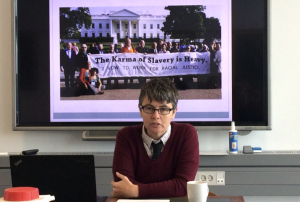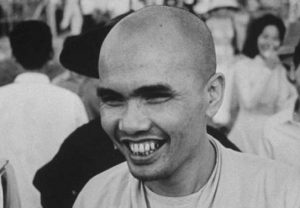I had the privilege of being at the Global Buddhist Congregation from the 27th to 30th of November 2011, which brought Buddhists of almost every tradition of the world together in New Delhi. Sa?ghas, Buddhist organizations, institutions, and scholars gathered from forty-six countries to recognize solidarity with each other amidst global economic and social uncertainty, as well as considerable potential challenges to the survival of Buddhism and humanity in the form of extremist ideologies and the ever-lurking threat of nuclear war. To assemble in New Delhi was a nod to the origin of Buddhism and the heritage of its founder, despite the fact that Buddhism only accounts for 0.02% of the modern Indian population. Restoring Buddhism’s presence in its homeland is imperative for reinvigorating the Buddhist intellectual and cultural heritage that was cut short in the twelfth and thirteenth centuries, even as its influence persisted in many other regions.
There was an additional, and perhaps even more ambitious agenda at the conference. It is to form an International Buddhist Confederation (IBC), which is exactly what its name denotes – an international confederate of Buddhist traditions and cultures, based in the Indian capital of New Delhi. During the days of the Global Buddhist Congregation, an IBC Working Committee – whose membership was formed by invitation to the delegates of the GBC event, adopted a drafted resolution. Additional memberships were accepted on a self-nominated basis. It should be noted that this Working Committee is not the committee that will run the affairs of the future IBC, but in the meantime, steer the formation and progress of such an ambitious undertaking. It is reasonable to expect that those who help to form the IBC will have a privileged vantage point from which to influence it. This IBC is a grand proposal to answer the quandary of re-establishing Buddhism in India, and to recognize India as the birthplace of Buddhadharma. It is crucial to re-establish Buddhism as a major religion in the country by diverse and effective methods.
Still in its early stages, the objectives of the IBC are incredibly ambitious, broad, and sweeping. They are nothing short of audacious and if they could actually be implemented with real results in the next few decades, the Confederation would truly prove itself as a formidable transnational sa?gha backed by the spiritual and moral weight of most Buddhist lineage leaders. But what about the voices of the average Buddhist monastic or the layman?
A word of caution is necessary. If we are expected to defer our personal opinions about certain aspects of Buddhist-related policy (in any part of the world) to the future Committee that will speak on behalf of the Sa?gha of the Four Directions, then we will do so if its decisions are made in conformity to the Buddha’s own life and actions. But the actual structure and functioning of the IBC’s authorities should be made clear, transparently, to Buddhists across the world as the body is gradually formed.
My personal hope is that this long-awaited objective of restoring Indian Buddhism can begin to show signs of fruition within our lifetimes. Indeed, the state of Buddhism in India and Nepal is in many ways in a more precarious and fragile state than ever before. This needs to be addressed as a collective embarrassment and as urgently as any Buddhist institute or seminary can afford. That the IBC will be headquartered in the heart of India makes me tentatively hopeful that progress will be sound, if the promises of the IBC take root.
I openly shared my concerns about the process with Buddhistdoor’s Spiritual Director. One particularly sensitive point was the purport of the IBC to represent women. With the exception of a representative from Jamaica, and perhaps a couple others, the vast majority of the IBC’s Working Committee was comprised of men. This is a not an ideal start. Already, one of the explicitly listed objectives in the Resolution adopted by the GBC 2011 has already been jeopardized. Also, there is the issue of Buddhist geopolitics. Will more influential Buddhist countries like Bhutan and Nepal have a greater representation and say than those where Buddhism is only just beginning to grow, like Uganda or Argentina? What about Russia, the Ukraine, and Eastern European countries like Poland, which are growing in adherents and every bit as crucial for Buddhism’s future as Western Europe? And we must not forget that Bhutan and Nepal represent primarily the Vajray?na traditions – will the IBC’s board be divided into one-third Vajray?na, one-third Therav?da, and one-third Mah?y?na? How will the political function of checks and balances be applied so that proceedings and deliberations at the IBC will be conducted fairly and democratically? How would a federal body look like?
And when all the concerns above are addressed – when all is said and done – will the IBC be able to function as a common platform that projects “a united voice” and develops “a common response, based on the collective wisdom of all Buddhist traditions” (Resolution, 29/11/2011)?
Let’s inverse the dynamics of influence for the IBC. Let’s have a 60% majority of female Buddhist leaders with a lesser ratio of 40% male. Then, let us nominate and vote in Buddhist leaders from the countries that Buddhism is most fragile in, not established: this would mean that the authority of the IBC consists of representatives from minority Buddhist countries in Latin America, Eastern Europe, and of course, the Indian subcontinent itself (India and Bangladesh come to mind). Without excluding the traditionally vigorous voices of East Asian, Western European, North American and South-East Asian Buddhist countries, let’s ensure this IBC will be, unquestionably, the strongest and fairest global Dharma body in history.















